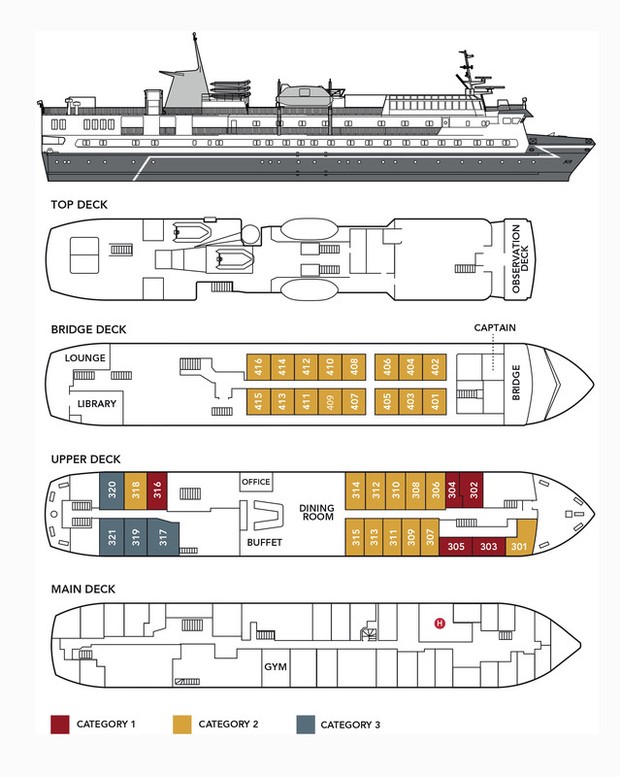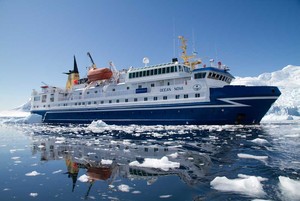
Scotland’s magnificent coastline is an indented landscape of enormous natural splendour with offshore islands forming stepping stones into the Atlantic and this voyage will appeal to those who want to explore the wonderful scenery and the abundant bird and wildlife. If you have always had a hankering to visit some of the remotest and most inaccessible islands in Scotland, this is the ideal opportunity. Few cruise ships offer the chance to explore in-depth the islands off the northern coast of Scotland and this unique itinerary ventures far north to the Shetland and Orkney Islands as well as the magical Hebridean islands. Join us aboard the 84-passenger Ocean Nova as we sail from the port of Oban to the islands on the edge, visiting both inhabited and uninhabited islands and places of great natural beauty, rich in wildlife and many with a long history dating back to the Iron Age.
Such a trip would be almost impossible to arrange independently and requires a small ship with the expeditionary qualities of the Ocean Nova. With just over eighty travelling companions, the atmosphere on board is convivial and when ashore with our local experts and expedition team, we will divide into small groups thereby enjoying a comprehensive and peaceful experience. We will witness vibrant colours and amazingly prolific birdlife, explore deserted villages and learn of the history and ancient culture of unique island life.
- St Kilda, Outer Hebrides: Explore the uninhabited archipelago of St Kilda, a UNESCO World Heritage Site, with its towering cliffs and thousands of seabirds.
- Fingal's Cave, Staffa: Visit the remarkable Fingal's Cave on Staffa, featuring imposing basalt columns and cathedral-like caverns.
- Jarlshof, Shetland Islands: Discover the archaeological site of Jarlshof, showcasing 5,000 years of history with Neolithic houses, Norse longhouses, and more.
Prices quoted here are often dependent on currency fluctuations. Please check with (01432 507450 or info@small-cruise-ships.com) for the very latest price, which may well be cheaper than the one advertised here.
Embark the Ocean Nova this afternoon. A transfer will be provided from Glasgow International Airport and Central Railway Station at a fixed time. Enjoy welcome drinks and dinner as we sail this evening.
Gigha is a place apart; heather covered hills, deserted beaches and a single lane verged with wildflowers that meander for some six miles between cottages and farms. Privately owned by its 120 inhabitants, it is a gem of a place and somewhere not easily forgotten. After landing by Zodiac, we will walk to the gardens of Achamore House where the Horlick family have created a lovely and eclectic garden with their collection of azaleas, rhododendrons and exotic plants. This afternoon we will use our Zodiacs to land on Jura. We will go ashore at Craighouse and will be welcomed in the cooperage where we will be given an introduction to the Jura Distillery and an opportunity to taste the local product. Alternatively, join one of our naturalists on a walk along the shore.
At first light we arrive at Staffa where the perpendicular rock face features an imposing series of black basalt columns, known as the Colonnade, which has been cut by the sea into cathedralesque caverns, most notably Fingal’s Cave. Weather permitting, we will use our Zodiacs to explore closer. This afternoon we sail to the Treshnish Isles, an archipelago of uninhabited volcanic islets. The island of Lunga is the largest of the Treshnish Isles in Argyll and Bute. Of volcanic origin, Lunga has been described as ‘a green jewel in a peacock sea’ and is a summer nesting-place for hundreds of seabirds.
Today we explore the Isle of Skye. From our anchorage in Loch Harport we will Zodiac ashore to Carbost and then on to the MacLeod stronghold of Dunvegan Castle. Remarkably, the castle has been almost continuously occupied by the MacLeods for nearly eight centuries. Tour the castle, a fascinating place that contains work from at least ten building periods. Then explore the gardens, following paths through woodland glades past pools and burns fed by a waterfall. The formal gardens were laid out in the 18th century and make a wonderful contrast to the moorland hills and sea. Also keep a look out for the seal colony on the adjoining rocks. Over lunch we will sail to Loch Scavaig. Just beyond is the freshwater Loch Corruisk with its breathtakingly beautiful view over the Cuillins. This is great walking country, but for those who prefer a less energetic morning our Zodiacs will explore the coast looking out for seals.
This morning we cruise past two of the largest gannetries in the world at Stac Lee and Boreray. These impressive stacs rise 170 metres from the sea and are home to up to 60,000 breeding pairs of northern gannets. Arrive this afternoon at St Kilda, a remarkable uninhabited archipelago some 50 miles beyond the Outer Hebrides. Dominated by the highest cliffs and sea stacks in Britain, Hirta, St Kilda’s main island was occupied on and off for at least 2,000 years, with the last 36 Gaelic speaking inhabitants evacuated at their own request in 1930. Immediately after the evacuation, the island was bought by the Marquess of Bute to protect the island’s thousands of seabirds including puffins and fulmars, and in 1957 it was bequeathed to the National Trust for Scotland. St Kilda is one of the few UNESCO World Heritage Sites with dual status reflecting its natural and cultural significance. The local ranger will join us on board before our expedition staff lead several guided walks on the island.
Spend the morning at sea, maybe join a lecture or find a spot on deck to watch for wildlife. Over lunch we arrive at Handa where we will use our Zodiacs to explore the magnificent sea cliffs of Torridonian sandstone which rise from the Atlantic. The island comes alive each spring when nearly 100,000 seabirds gather to breed, including internationally important numbers of guillemot, razorbill, puffins and great skua.
This morning we visit Foula, one of Britain’s most remote inhabited islands. Apart from a narrow coastal strip of more fertile croftland, Foula is an expanse of peat and moorland rising steeply to five dramatic peaks. In spring, Foula’s wildflowers provide a glorious burst of colour. Translated as “Bird Island” from Old Norse the island is designated as a Special Protection Area for birds and is home to the world’s largest colony of great skuas, known locally as bonxies, which compete fiercely with Arctic skuas for breeding territories. Kittiwakes and Arctic terns return annually to nest whilst the cliffs team with puffins, shags and fulmars. Over lunch we will sail the short distance to Papa Stour where we will use our Zodiacs to explore the stunning cliff scenery, sea stacks, arches, blowholes and coastal caves which are home to Arctic skua and large numbers of Arctic terns.
We arrive into the Shetlands at the northern island of Unst. Unst is Britain’s most northerly inhabited island and at the Heritage Centre we will learn about the islanders’ struggles over the centuries and the industries that have prospered whilst the Unst Boat Haven is dedicated to the history of the island’s distinctive wooden boats which descend from Viking craft. We also visit Saxa Vord with views over Hermaness National Nature Reserve and Muckle Flugga stacks and home to thousands of gannets and puffins as well as rare arctic-alpine plants. Over lunch we sail to Fetlar, inhabited for over 5,000 years the island lays claim to being the first Norse landing site in the Shetlands. Known as the most fertile of the Shetland Islands, the wildflowers bring colour to the landscape whilst the birdlife on the island is prolific. Our expedition team will lead walks ashore including the Fetlar Interpretative Centre and Museum where we will learn about the wildlife and archaeological history of the island.
From the Shetland capital, we will visit the remarkable archaeological site of Jarlshof. The site was uncovered by a violent storm in the winter of 1896/7, revealing an extraordinary settlement site embracing at least 5,000 years of human history. The site contains a remarkable sequence of stone structures – late Neolithic houses, a Bronze-Age village, an Iron-Age broch and wheelhouses, several Norse longhouse, a Medieval farmstead, and the 16th century laird’s house. Return to the ship for lunch and enjoy a free afternoon to explore this historic port. Perhaps wander through its narrow stone lanes or maybe visit the excellent Shetland Museum, containing artefacts from shipwrecks and the whaling era. Tonight we will be entertained by local musicians before we sail.
Arriving in the Orkney Islands we will visit the bird observatory on North Ronaldsay. Here the range of wetland habitats supports the wildfowl and wader species whilst the rugged coastline provides nesting sites for seabird colonies. Whilst walking on the island we will keep an eye out for ringed plovers, sanderlings and dunlins which gather on the heath. We can also view the seals hauled up on the beaches and those wishing to explore further can visit the lighthouse with views over the nearby islands or visit the wool mill. This afternoon we will sail for the Scottish mainland.
Disembark this morning. Transfers will be provided to Aberdeen Airport and Railway Station at a fixed time.
Itineraries are subject to change.
Ocean Nova

| Ice Class: | Ice 1B, E0 (Hull Ice 1A) |
|---|---|
| Cabins | 37 |
The ice-strengthened 73 metre long expedition ship Ocean Nova was built in Denmark in 1992 with high ice class to serve Greenland’s west coast. In 2004 to 2005 she was completely refurbished and has now a career as a small and comfortable expedition ship. The Ocean Nova accommodates 86 passengers in single, double and triple cabins, all with sea-view and private facilities. The double cabins have either twin beds. The triple cabins have upper and lower beds. In your cabin you will also find a desk with chair and ample storage space for clothes and equipment.
In the dining room you are treated to delicious meals in between landings and in the panorama lounge you can enjoy a drink with a breathtaking view of the surrounding polar landscape. This is where on board specialists entertain and educate you with lectures on polar biology, history, geology and conservation. There is also a library with panoramic views and a good selection of polar books. On board there is a satellite phone, gym and medical doctor. Passengers are welcome on the bridge around the clock and there is always something to see or search for from the spacious observation decks. The ship has North European officers and there is a friendly and informal atmosphere on board. Travelling with this small expedition ship offers an entirely different experience and perspective than you can get on a larger and more conventional cruise ship.
Cabins are spread over two decks and include cabins for the single traveller, double and triple cabins, all with sea-view and private facilities. The comfortable dining room located on the Upper deck seats all passengers in a single sitting and offers delicious meals with a mixture of table service and buffet. The informal dining arrangement adds to the friendly atmosphere onboard and meals are a great chance to discuss all you have seen with your fellow travellers, and for the expedition team to share their knowledge.
With one of the highest ice classes (1B) and a 2000 hp diesel engine, Ocean Nova is a small but sturdy expedition vessel just as at home in the icy waters of Svalbard as she is in a tranquil Scottish loch. The ship has a crew of 34, including North European officers, whose prime concern is your safety as well as ensuring wildlife sightings and weather conditions are maximised. For your safety there are two fully enclosed lifeboats and a medical clinic onboard.



